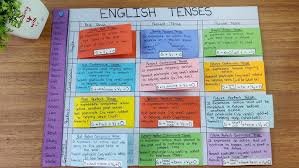Ever struggled to express your thoughts clearly in English? Understanding verb forms can change the way you communicate. Mastering different time expressions helps convey messages with accuracy. Whether writing or speaking, knowing the right form enhances fluency. A well-organized approach simplifies learning and improves confidence.
A structured breakdown makes it easier to grasp different timeframes. The structure of the tenses chart provides a visual reference to understand patterns. With clear guidelines, forming sentences correctly becomes second nature. Let’s explore a step-by-step method to unlock the power of time-based expressions.
Present Tense for Everyday Situations
The present form is essential for daily interactions. It helps describe routines, habits, and general facts. When discussing ongoing events, variations in structure create meaningful expressions. Learning these forms sharpens both written and spoken language skills. Consistent exposure to different sentence structures builds natural fluency over time.
For effective use, recognize the difference between simple and continuous forms. Both play a role in sharing current events or ongoing actions. Advanced structures also highlight planned activities. A systematic approach helps in mastering these patterns smoothly.
Past Tense for Expressing Completed Actions
Talking about past events requires the correct word arrangement. Understanding variations in past forms allows for accurate storytelling. Describing experiences, completed actions, or past habits becomes effortless with structured learning. The right approach removes confusion and improves clarity. Applying structured techniques ensures accuracy in narration.
Simple and continuous past forms play a significant role in expressing events. Their proper usage prevents common errors while speaking or writing. Organizing ideas with past expressions helps make conversations more engaging. A clear breakdown simplifies the learning process. Recognizing patterns in past expressions improves sentence flow and confidence in usage.
Future Tense for Describing Upcoming Events
Projecting future plans requires the right expressions. Whether discussing intentions, predictions, or scheduled activities, structuring thoughts correctly matters. Various forms allow speakers to communicate planned or uncertain events smoothly. Choosing the appropriate structure ensures messages are delivered clearly. Understanding different future forms helps in avoiding miscommunication.
Learning future expressions helps improve accuracy in conversations. The right approach eliminates hesitation while forming sentences. A detailed reference provides clarity on constructing time-based statements. With continuous practice, expressing future plans becomes effortless. Developing a structured practice routine ensures long-term mastery of future tense expressions.
Combining Tenses for Effective Storytelling
Switching between different expressions enhances storytelling skills. Many situations require using multiple forms to provide context. Seamless transitions between different timeframes make discussions engaging. Knowing when to shift expressions keeps the listener or reader engaged. Mastering the art of transitioning between timeframes strengthens language skills.
A structured approach aids in balancing different sentence patterns. Proper learning techniques help in forming complex yet clear statements. Practice strengthens fluency, making it easier to adjust to various situations. Mastering these patterns leads to stronger communication. The ability to blend different expressions smoothly improves both writing and speaking abilities.
Common Errors and How to Avoid Them
Mistakes in word placement can lead to misinterpretation. Mixing forms incorrectly often changes the meaning of a sentence. Identifying and correcting common mistakes improves clarity. Understanding these pitfalls helps develop better language skills. Recognizing frequently misused patterns prevents the repetition of errors.
A detailed chart simplifies complex structures, ensuring accuracy. Practicing with proper references minimizes grammatical mistakes. Paying attention to sentence construction prevents confusion. Applying corrections consistently enhances fluency over time. Developing a checklist for self-review strengthens accuracy in sentence formation.
Using a structured reference strengthens sentence-building skills. Breaking down rules into smaller sections simplifies the process. A structure of the tenses chart ensures consistency and confidence in language use. With regular practice, structuring sentences correctly becomes second nature. Reviewing and applying structured references in daily communication reinforces long-term retention.
